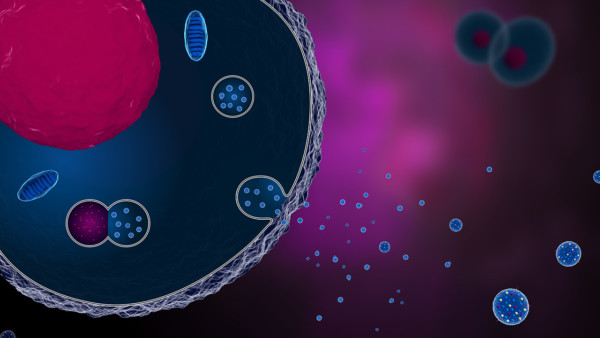PRP Exosomes and Cartilage Repair

Meletios Verras/Shutterstock
Platelet-rich plasma is the most commonly used regenerative treatment in the U.S. right now. In these past few years, exosomes have also been a hot topic. Does PRP have exosomes? If so, what can they do? Let’s dig in and review some new research.
What Is an Exosome?
An exosome is a small vesicle produced by a cell that can tell other cells what to do (1). This is literally how cells speak to each other. So think of exosomes as the words and phrases between cells. One cell may want to command another cell to do something, so it sends exosomes to that cells to relay the message. These small little vesicles carry different types of things like mRNA and growth factors (2).
There Are Many Different Types of Exosomes
There are at least a few hundred different types of exosomes that can all do different things (3). The problem we have right now is that no one is clear on how to isolate specific exosomes that code for discrete actions like fixing your cartilage, ligaments, tendons, muscles, or nerves. In addition, not all exosomes are helpful. For example, two exosome types have been identified that are associated with a higher death rate in hospitalized patients (4). Hence, using exosomes as a stand-alone treatment is something that is not yet ready for prime time. This hasn’t stopped many people from advertising that they’re selling exosomes in a vial, but this has led the FDA to crack down on these companies and clinics due to safety concerns:

Your PRP Has Exosomes
PRP stands for platelet-rich plasma. PRP is made by taking your blood and concentrating your platelets. We often use highly concentrated PRP at Regenexx to help patients with musculoskeletal pain.
The existing illegal exosome market is heavily focused on creating products derived from birth tissues. However, what this sales pitch forgets is that just about every cell in your body produces exosomes, which include non-cellular fragments like platelets. So is PRP made from your own blood an exosome therapy?
Platelets release many different types of exosomes (5-10). In addition, even bursting the platelets open to create platelet lysate still keeps these exosomes intact (11). As with the cells in your body, platelets release exosomes depending on what the platelet senses in its local environment and when, so these messages are tailed to what’s going on and what needs to be done (12).
Platelet-derived exosomes may have big therapeutic effects. For example, these platelet exosomes can cross the tough to penetrate the Blood-Brain Barrier and help new nerve cells to grow (13). In addition, an experimental exosome treatment derived from PRP was able to heal the type of chronic skin ulcers seen in diabetics and even prevent osteonecrosis (a bone disease) (14,15).
The New Research on PRP, Exosomes, and Cartilage Repair
Can the exosomes found in PRP repair cartilage by themselves? Researchers in Asia recently made PRP and then also isolated the exosomes from PRP (16). They exposed both mixes to cartilage cells and looked at things like cell growth, the ability to close a tear or gap, helping cartilage cells deal with bad inflammation, and resisting apoptosis (cell death). The PRP and the PRP-derived exosomes without platelets performed similarly. Interestingly, the exosomes did better in some tasks, but that result should be taken with a grain of salt as the exosomes were more concentrated than those found in the PRP sample. This makes sense, as we know from many experiments done at Regenexx and our own published research on tenocytes that more concentrated PRP gets better results (17).
The Future?
One day we could have a legitimate PRP-derived exosome product that’s off the shelf. Once we learn more about these effects, we could dial in things like cartilage repair or tendon healing. What remains to be seen is whether anything like this would be any better than using the patient’s own PRP which would likely be much cheaper. Only time will tell.
The upshot? PRP is really cool stuff. It’s a legal exosome therapy that you can access any time with a simple blood draw!
_______________________________
References:
(1) Yin K, Wang S, Zhao RC. Exosomes from mesenchymal stem/stromal cells: a new therapeutic paradigm. Biomark Res. 2019;7:8. Published 2019 Apr 4. doi: 10.1186/s40364-019-0159-x
(2) Kusuma GD, Carthew J, Lim R, Frith JE. Effect of the Microenvironment on Mesenchymal Stem Cell Paracrine Signaling: Opportunities to Engineer the Therapeutic Effect. Stem Cells Dev. 2017 May 1;26(9):617-631. doi: 10.1089/scd.2016.0349.
(3) Nolan JP, Jones JC. Detection of platelet vesicles by flow cytometry. Platelets. 2017;28(3):256–262. doi: 10.1080/09537104.2017.1280602
(4) Danesh A, Inglis HC, Abdel-Mohsen M, et al. Granulocyte-Derived Extracellular Vesicles Activate Monocytes and Are Associated With Mortality in Intensive Care Unit Patients. Front Immunol. 2018;9:956. Published 2018 May 8. doi: 10.3389/fimmu.2018.00956
(5) Parsons MEM1, Szklanna PB1, Guerrero JA, et. al. Platelet Releasate Proteome Profiling Reveals a Core Set of Proteins with Low Variance between Healthy Adults. Proteomics. 2018 Aug;18(15):e1800219. doi: 10.1002/pmic.201800219.
(6) Walsh TG, Poole AW. Do platelets promote cardiac recovery after myocardial infarction: roles beyond occlusive ischemic damage. Am J Physiol Heart Circ Physiol. 2018;314(5):H1043–H1048. doi: 10.1152/ajpheart.00134.2018
(7) Preußer C, Hung LH, Schneider T, et al. Selective release of circRNAs in platelet-derived extracellular vesicles. J Extracell Vesicles. 2018;7(1):1424473. Published 2018 Jan 15. doi: 10.1080/20013078.2018.1424473
(8) Tao SC, Guo SC, Zhang CQ. Platelet-derived Extracellular Vesicles: An Emerging Therapeutic Approach. Int J Biol Sci. 2017;13(7):828–834. Published 2017 Jul 6. doi: 10.7150/ijbs.19776
(9) Brisson AR, Tan S, Linares R, Gounou C, Arraud N. Extracellular vesicles from activated platelets: a semiquantitative cryo-electron microscopy and immuno-gold labeling study. Platelets. 2017 May;28(3):263-271. doi: 10.1080/09537104.2016.1268255
(10) Aatonen M, Valkonen S1, Böing A, Yuana Y, Nieuwland R, Siljander P. Isolation of Platelet-Derived Extracellular Vesicles. Methods Mol Biol. 2017;1545:177-188. https://www.ncbi.nlm.nih.gov/pubmed/27943214
(11) Torreggiani E, Perut F, Roncuzzi L, Zini N, Baglìo SR, Baldini N. Exosomes: novel effectors of human platelet lysate activity. Eur Cell Mater. 2014 Sep 22;28:137-51; discussion 151. https://www.ncbi.nlm.nih.gov/pubmed/25241964
(12) Aatonen MT, Ohman T, Nyman TA, Laitinen S, Grönholm M, Siljander PR. Isolation and characterization of platelet-derived extracellular vesicles. J Extracell Vesicles. 2014;3:10.3402/jev.v3.24692. Published 2014 Aug 6. doi: 10.3402/jev.v3.24692
(13) Leiter O, Walker TL. Platelets: The missing link between the blood and brain? Prog Neurobiol. 2019 Dec;183:101695. doi: 10.1016/j.pneurobio.2019.101695.
(14) Tao SC, Yuan T, Rui BY, Zhu ZZ, Guo SC, Zhang CQ. Exosomes derived from human platelet-rich plasma prevent apoptosis induced by glucocorticoid-associated endoplasmic reticulum stress in rat osteonecrosis of the femoral head via the Akt/Bad/Bcl-2 signal pathway. Theranostics. 2017;7(3):733–750. Published 2017 Jan 15. doi: 10.7150/thno.17450
(15) Guo SC, Tao SC, Yin WJ, Qi X, Yuan T, Zhang CQ. Exosomes derived from platelet-rich plasma promote the re-epithelization of chronic cutaneous wounds via activation of YAP in a diabetic rat model. Theranostics. 2017;7(1):81–96. Published 2017 Jan 1. doi: 10.7150/thno.16803
(16) Liu X, Wang L, Ma C, Wang G, Zhang Y, Sun S. Exosomes derived from platelet-rich plasma present a novel potential in alleviating knee osteoarthritis by promoting proliferation and inhibiting apoptosis of chondrocyte via Wnt/β-catenin signaling pathway. J Orthop Surg Res. 2019;14(1):470. Published 2019 Dec 30. doi:10.1186/s13018-019-1529-7
(17) Berger DR, Centeno CJ, Steinmetz NJ. Platelet lysates from aged donors promote human tenocyte proliferation and migration in a concentration-dependent manner. Bone Joint Res. 2019;8(1):32-40. Published 2019 Feb 2. doi:10.1302/2046-3758.81.BJR-2018-0164.R1

NOTE: This blog post provides general information to help the reader better understand regenerative medicine, musculoskeletal health, and related subjects. All content provided in this blog, website, or any linked materials, including text, graphics, images, patient profiles, outcomes, and information, are not intended and should not be considered or used as a substitute for medical advice, diagnosis, or treatment. Please always consult with a professional and certified healthcare provider to discuss if a treatment is right for you.
